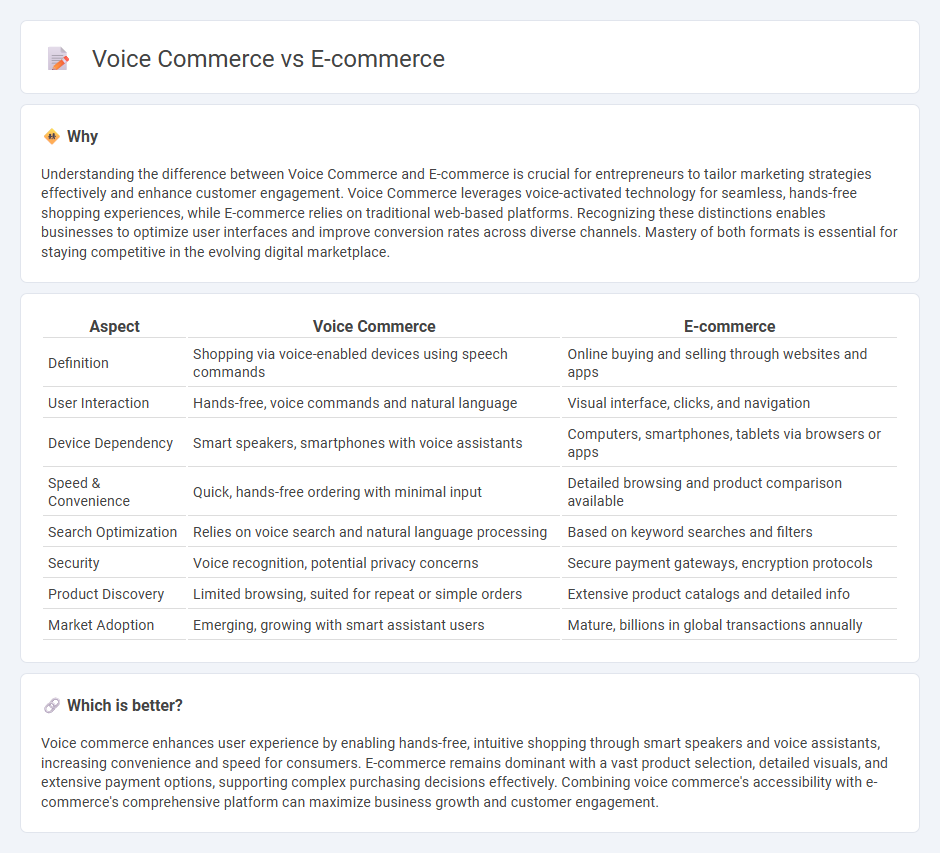
Voice commerce leverages voice recognition technology to enable hands-free shopping through smart speakers and virtual assistants, transforming the traditional e-commerce experience. This method enhances convenience and speed for consumers, especially in mobile and multitasking environments, while e-commerce relies on visual interfaces and manual input. Explore further to understand how these two paradigms are reshaping the future of digital retail.
Why it is important
Understanding the difference between Voice Commerce and E-commerce is crucial for entrepreneurs to tailor marketing strategies effectively and enhance customer engagement. Voice Commerce leverages voice-activated technology for seamless, hands-free shopping experiences, while E-commerce relies on traditional web-based platforms. Recognizing these distinctions enables businesses to optimize user interfaces and improve conversion rates across diverse channels. Mastery of both formats is essential for staying competitive in the evolving digital marketplace.
Comparison Table
| Aspect | Voice Commerce | E-commerce |
|---|---|---|
| Definition | Shopping via voice-enabled devices using speech commands | Online buying and selling through websites and apps |
| User Interaction | Hands-free, voice commands and natural language | Visual interface, clicks, and navigation |
| Device Dependency | Smart speakers, smartphones with voice assistants | Computers, smartphones, tablets via browsers or apps |
| Speed & Convenience | Quick, hands-free ordering with minimal input | Detailed browsing and product comparison available |
| Search Optimization | Relies on voice search and natural language processing | Based on keyword searches and filters |
| Security | Voice recognition, potential privacy concerns | Secure payment gateways, encryption protocols |
| Product Discovery | Limited browsing, suited for repeat or simple orders | Extensive product catalogs and detailed info |
| Market Adoption | Emerging, growing with smart assistant users | Mature, billions in global transactions annually |
Which is better?
Voice commerce enhances user experience by enabling hands-free, intuitive shopping through smart speakers and voice assistants, increasing convenience and speed for consumers. E-commerce remains dominant with a vast product selection, detailed visuals, and extensive payment options, supporting complex purchasing decisions effectively. Combining voice commerce's accessibility with e-commerce's comprehensive platform can maximize business growth and customer engagement.
Connection
Voice commerce leverages spoken language technology to enable seamless shopping experiences, directly integrating with e-commerce platforms to facilitate hands-free transactions. Entrepreneurs utilize voice-activated devices to enhance customer engagement and streamline the purchasing process, driving higher conversion rates in digital retail. The synergy between voice commerce and e-commerce is transforming traditional online shopping by prioritizing convenience and accessibility through advanced AI-driven voice recognition systems.
Key Terms
Online Shopping
E-commerce dominates online shopping by offering vast product selections and secure payment options through websites and apps, driving global sales beyond $5 trillion annually. Voice commerce leverages AI-driven assistants like Amazon Alexa and Google Assistant to enable hands-free, conversational shopping experiences that simplify reordering and product searches. Explore how integrating voice technology can transform customer engagement and boost e-commerce growth.
Voice Assistant
Voice commerce leverages voice assistants like Amazon Alexa, Google Assistant, and Apple Siri to enable hands-free shopping experiences, allowing users to search and purchase products using simple voice commands. This technology integrates seamlessly with smart home devices, offering convenience and efficiency over traditional e-commerce interfaces. Explore how voice assistants are transforming retail by providing personalized, faster, and more accessible shopping solutions.
User Experience
E-commerce platforms rely on visual interfaces and detailed navigation to enhance user experience, enabling customers to browse, compare, and purchase products efficiently. Voice commerce prioritizes conversational interaction through AI-driven voice assistants, offering a hands-free, faster shopping experience with natural language understanding and personalized recommendations. Explore the evolving trends and usability insights shaping the future of digital shopping.
Source and External Links
What Is Ecommerce? Guide To Selling Online (2025) - Ecommerce is the buying and selling of goods and services over the internet, encompassing types like direct to consumer (DTC), business to business (B2B), and consumer to consumer (C2C).
Glossary:E-commerce - Statistics Explained - Eurostat - E-commerce is broadly defined as electronic transactions of goods or services between businesses, individuals, or organizations conducted via the internet or other online communication networks.
E-commerce - Wikipedia - E-commerce involves online buying and selling with key categories like B2B, B2C, B2G, C2B, and C2C, and supports activities such as retail sales, auctions, and online marketplaces.
 dowidth.com
dowidth.com